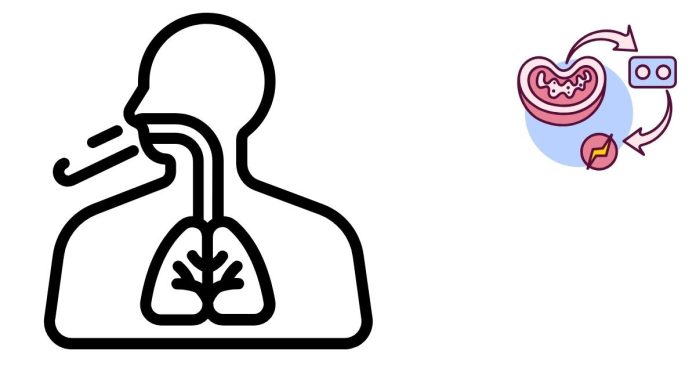Cellular respiration is the process by which cells convert glucose and oxygen into usable energy in the form of ATP (adenosine triphosphate). It also produces carbon dioxide (CO₂) and water (H₂O) as waste products. The energy produced is used by the cell for various functions like growth, repair, and maintaining homeostasis.
Cellular respiration can occur in three major stages:
- Glycolysis
- Krebs Cycle (Citric Acid Cycle)
- Electron Transport Chain (ETC)
Each stage occurs in a specific part of the cell:
- Glycolysis occurs in the cytoplasm.
- The Krebs cycle and electron transport chain occur in the mitochondria.
Stage 1: Glycolysis (Anaerobic Process)
- Location: Cytoplasm
- Process: Glycolysis is the first step in breaking down glucose (a 6-carbon sugar). It does not require oxygen and is therefore considered anaerobic.
- Steps:
- One molecule of glucose (C₆H₁₂O₆) is split into two molecules of pyruvate (C₃H₄O₃).
- In the process, 2 ATP molecules are consumed, but 4 ATP molecules are produced, giving a net gain of 2 ATP.
- Also, 2 NADH molecules (electron carriers) are produced.
- Output: 2 pyruvate molecules, 2 ATP (net), and 2 NADH.
Although glycolysis itself does not produce much ATP, it sets up the next stages by producing the pyruvate and NADH needed for the Krebs cycle and the electron transport chain.
Stage 2: Krebs Cycle (Citric Acid Cycle)
- Location: Mitochondrial matrix (inside the mitochondria)
- Process: The pyruvate produced in glycolysis is transported into the mitochondria, where it undergoes several transformations.
- Pyruvate is converted into Acetyl-CoA (a 2-carbon molecule) by a process called decarboxylation, releasing CO₂ as a waste product.
- Acetyl-CoA then enters the Krebs cycle, where it is further broken down, producing more ATP, NADH, FADH₂ (another electron carrier), and CO₂ as a byproduct.
- For each pyruvate (remember, there are 2 pyruvate molecules per glucose molecule), the cycle produces:
- 3 NADH
- 1 FADH₂
- 1 ATP (via substrate-level phosphorylation)
- 2 CO₂ (waste)
- Output: For each glucose molecule, the cycle runs twice (once for each pyruvate), producing 6 NADH, 2 FADH₂, 2 ATP, and 4 CO₂.
The NADH and FADH₂ produced here are critical for the next stage, the electron transport chain.
Stage 3: Electron Transport Chain (ETC) and Oxidative Phosphorylation
- Location: Inner mitochondrial membrane
- Process: This stage requires oxygen, making it aerobic.
- The NADH and FADH₂ produced in earlier stages donate their electrons to the electron transport chain, which is a series of protein complexes embedded in the inner mitochondrial membrane.
- As electrons pass through the ETC, they lose energy, which is used to pump protons (H⁺ ions) from the mitochondrial matrix into the intermembrane space, creating a proton gradient.
- The protons flow back into the matrix through ATP synthase, which uses the energy of this flow to generate ATP from ADP and inorganic phosphate (Pi) — a process known as oxidative phosphorylation.
- The electrons eventually combine with protons and oxygen (O₂) to form water (H₂O) as a byproduct.
- Output:
- The ETC produces 32 to 34 ATP (most of the ATP from cellular respiration comes from this stage).
- Water (H₂O) is produced when electrons combine with oxygen and protons at the end of the chain.
Oxygen is essential for the final step because it acts as the final electron acceptor. Without oxygen, the electron transport chain cannot function, and ATP production would halt.
Total ATP Production from Cellular Respiration
From one molecule of glucose (C₆H₁₂O₆), the complete process of cellular respiration can produce up to 36 to 38 ATP molecules, depending on the efficiency of the system in a given cell:
- Glycolysis produces 2 ATP.
- Krebs cycle produces 2 ATP.
- Electron transport chain and oxidative phosphorylation produces 32 to 34 ATP.
Summary of the Equation for Cellular Respiration:
C₆H₁₂O₆)+6O₂→6CO₂+6H₂O+ATP
In words, glucose (C₆H₁₂O₆) reacts with oxygen (O₂) to produce carbon dioxide (CO₂), water (H₂O), and ATP (the energy currency of the cell).
Why is Cellular Respiration Important?
Cellular respiration is fundamental for life because it provides the energy necessary for all cellular processes, including growth, repair, and maintaining the functions of the body. Without it, cells wouldn’t have the ATP needed for essential processes like protein synthesis, muscle contraction, and active transport across membranes.


